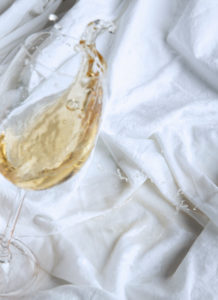
If you are a wine lover, you probably know that spills are quite a common occurrence. While stains are never welcome, white wine and champagne stains are one of the easiest to remove. Obviously, you would rather have a white wine stain than a red wine one. Even though they are pretty easy to remove and quite light in colour, it is best to begin treating those stains as soon as possible. Always check the care label of the fabric you are about to be cleaning and never place the garment in the dryer before the stain is completely gone – the heat may set the stain and make it hard to remove or even permanent.
Always blot as much moisture away as possible. Use a clean dry cloth and not a wet one since extra moisture may cause the stain to spread. If the fabric or garment is labelled as ‘’dry cleaning only’’ do not attempt any cleaning on your own since you may damage the garment. Instead, blot as much moisture away as possible and bring the stained piece to the dry cleaners as soon as possible.
How to remove white wine or champagne stains from washable clothing?
- The first step is always blotting. Use a clean dry cloth or a paper towel to absorb the excess moisture from the stained area. If you don’t have a clean cloth around, use a piece of white bread. Once you remove most of the excess wine from the stain, grab a cloth dipped in plain water to dilute the white wine and help the cleaning process.
- Wash the garment. Wash the piece of clothing as soon as possible. Use your regular cycle and a powerful liquid laundry detergent. Make sure the product you choose contains enough enzymes to properly break down the stain. Check the fabric care label and use the highest suitable temperature.
- Check the stained area. After washing the garment, check if the stain is completely gone. If it remains, do not throw the fabric in the dryer but continue with the next step instead.
- Mix a soaking solution – Mix oxygen bleach and water following the package instructions. Place the garment in the solution and let it sit overnight. When done, inspect the stained area once more and if the stain remains, make a fresh oxygen bleach solution and soak the garment once more.
Cleaning white wine and champagne stains from carpets and upholstery.
White wine and champagne stains on carpets can be cleaned using the same method as you would on upholstery. However, avoid oversaturating during the cleaning process. Excess moisture trapped in your upholstery may cause mould and mildew growth.
Before attempting any upholstery cleaning, make sure you check the label at the bottom of your furniture piece. If you stained a vintage, silk, or other fragile fabric, it is best to turn to a professional cleaning company and not attempt anything on your own since you are risking causing permanent damage.
- Blot the area – Grab a clean dry cloth and press at the stain. Absorb as much moisture as possible. That will help with the cleaning of the stain after.
- Flush the stained area – Flush the stained area using a sponge or a cloth dipped in plain water. Blot at the stain. That way you will dilute it and make it easier to remove. It will also prevent the sugars found in wine from getting trapped in the fabric and attracting dirt and grime in the future.
- Blot again – Once you are done flushing the stain, grab a dry cloth and blot some more. Make sure you absorb as much water as possible. Keep doing this until no more moisture is being absorbed from the surface of the carpet/upholstery.
- Air Dry and Vacuum – Let the carpet or upholstery air dry completely. To speed up the process, open your windows or place a fan near the cleaned area. Vacuum when done to fluff up the fabric fibres and restore the fresh look.
Additional tips on handling dried or old white wine or champagne stains
What if you can’t treat the stain right away or you didn’t notice the spill and now have a dried wine stain? Follow these tips to get rid of it for good:
- Mix a solution of 1 tablespoon liquid soap and 2 cu[ps of warm water
- Work the solution into the stained area of the carpet/upholstery using a soft sponge or a soft-bristles brush.
- Rinse the area with a clean sponge or a cloth dipped in plain water. Make sure you remove all soapy residue since it may attract dirt and soil in the future. Be careful to not oversaturate the surface of a furniture piece.
- Absorb as much moisture as possible using a clean dry cloth. Press at the stained area and move to a dry area of the cloth. Make sure you continue blotting the area until no more water is being absorbed.
- Allow the surface to air dry completely before vacuuming it to lift the fabric fibres.
